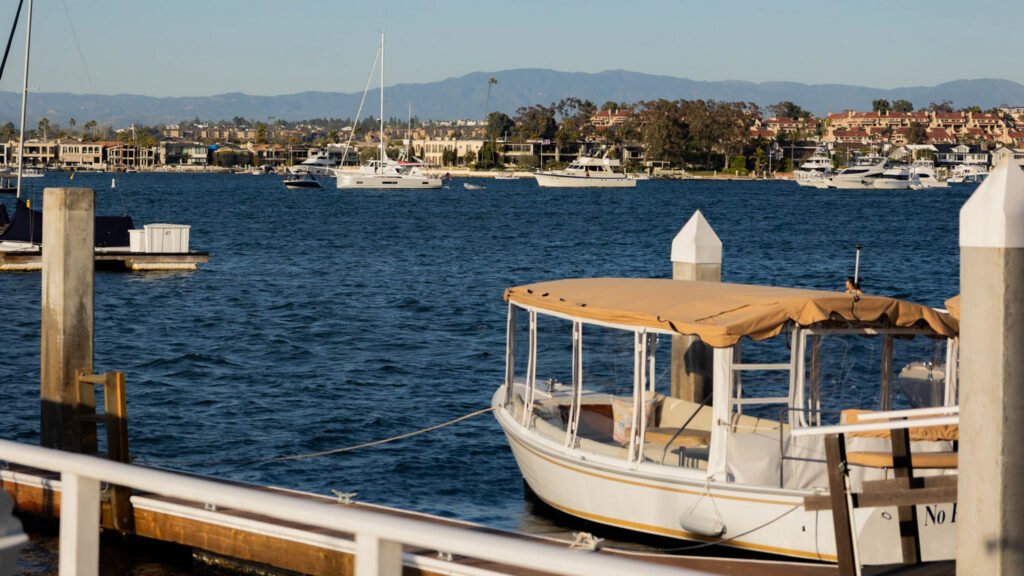California State Lands Commissioners Take a Stand on Newport Beach Mooring Management
As sunset casts a golden hue over Newport Harbor, the serene waters mask an undercurrent of discontent that threatens to disrupt the delicate balance between accessibility and environmental stewardship. Mooring permit holders in this picturesque Southern California locale are caught in a tumultuous battle with local officials, grappling with steep increases in docking fees that may quadruple their monthly costs.
For decades, Newport Harbor has served as a vibrant hub for boating enthusiasts, offering myriad options for storing vessels—from private residential piers connected to homes to offshore moorings, where boaters traverse the water to reach their crafts. Yet, as the California State Lands Commission recently stepped in to scrutinize the city’s management of these vital public resources, the conflict has intensified, casting a shadow over the future of waterfront living in Newport Beach.
Rising Tide of Concern
The Newport Beach City Council’s proposal to revise mooring fees marks a watershed moment for numerous residents who have long cherished their access to the harbor. Commission Chair Lt. Gov. Eleni Kounalakis emphasized the commission’s commitment to protecting public interests, stating, “While we don’t set the rates for the pier, it’s crucial that these public lands be managed equitably.” This stance aligns with sentiments voiced by economic experts who point to the implications of privatized access.
In a letter addressed to the city council, Marina Economics professor Dr. Thomas Green noted that “the staggering fee increases threaten not only access but also the spirit of community in a region dependent on its waterways for recreation and livelihood.” His research reveals that maintaining affordable access to public resources fosters local economies and sustainable tourism, and he warns that drastic fee hikes may “alienate long-time residents and local boating enthusiasts.”
The Price of Access
The current cost for offshore moorings stands at $3.34 per linear foot per month—approximately $133 for a 40-foot space. However, the proposed increase would soar to about $15 per linear foot, pushing the monthly bill to around $600. Under the new proposal, mooring permit holders would shift from robust ownership to day-to-day licenses controlled by the city. The Newport Mooring Association contends that this change undermines the very essence of boating culture in the area.
- A steep increase in monthly mooring fees could alienate local residents.
- The transition to city-managed licenses raises concerns about long-term accessibility.
- State commissioners worry about the constitutionality of privatized mooring transfers.
The Newport Mooring Association voiced their dissent, arguing that the city has consistently undervalued their voices throughout this process. “We find ourselves fighting for our right to access a public resource that should be available to all,” said Anne Stenton, the association’s president, after a recent state commission meeting.
Unpacking the Issues
Experts suggest that the current pricing structure favors certain private interests over community welfare. The state lands commission’s draft report indicated a significant disparity between the rates charged for residential piers and those for offshore moorings, suggesting that the city’s pricing strategy may constitute discrimination based on type of usage.
“There are clear differences in rate revisions for moorings and residential piers,” the report noted. “This may violate both the granting statute and the California constitution.” Such insights prompt critical questions about equitable access to public resources in coastal management.
Indeed, the state commission’s concerns bring to light the complexities of the harbor’s future. The alarming underpricing of residential piers, at 58 cents per square foot, raises eyebrows among community members, who advocate for fair market evaluations. “It’s about fairness and equal access for everyone, especially when these public resources have been historically undercharged,” said environmental law scholar Dr. Maya Lin. “California’s coastline belongs to its citizens, not just affluent homeowners.”
Community Responses to Regulatory Change
As discussions unfolded, liveaboard communities—those who reside permanently on their vessels—expressed fears of displacement. “We risk losing not just our homes but a way of life that defines us,” lamented Sam McDonald, a liveaboard advocate, during public hearings. “The higher costs are designed to eliminate us from the harbor. How are we to survive?”
In light of these developments, the Newport Mooring Association is mobilizing community members to advocate for a more transparent public review process. Stenton has called for a special meeting to further engage stakeholders in this critical debate. “Having less than 48 hours to comment on a significant report limits our voice,” she stressed during her remarks. “We need a platform to discuss implications and hold city officials accountable.”
The Path Forward
As the Newport Beach City Council and the State Lands Commission navigate this intricate web of conflicting interests, one thing is clear: the future of Newport Harbor hangs in the balance. The implications extend well beyond local boating enthusiasts; they ripple outward, affecting tourism, waterfront businesses, and even the region’s environmental integrity.
With the state commission expected to finalize their report later this year, residents are left contemplating whether their cherished harbor will remain a vibrant communal resource or become yet another slice of California’s coastline marred by exclusivity and escalating costs. Amid increasily aggressive policies, the heart of Newport Harbor beats anxiously, awaiting resolution.





